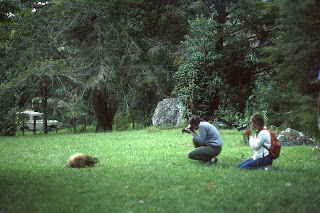I spent five months living in Gamboa, Panama during the dry season from January to May, 1983. I was one of three field assistants hired by Dr. Jim Karr to help him with a study of lowland tropical birds along the Panama Canal. We mist-netted hundreds of birds that represented more than fifty different species. We collected data on humidity, insect and fruit abundance, and vegetation. Jim was interested in the local movements of resident birds in relation to microhabitat conditions.
So what was the conclusion of all those net hours? I never learned if our specific research results were published. I do know that other tropical biologists followed along with more and different studies of birds. Hundreds of researchers continue to study a range of plants and animals and ecological processes in Gamboa, along Pipeline Road, on Barro Colorado Island, and beyond. Noriega is gone from Panama and the 60,000-acre Canal Zone was returned to the Republic of Panama, and they are in the midst of a huge expansion of the Canal. Protection of the canal's watershed and the tropical plants and animals that live there are part of their expansion plan. I like to think that our bit of information on birds and their habitats contributed, even if in a small way, to conserving lands along the canal.
A rosy thrush-tanager
I was 22 years old during this Panama adventure. The experience shaped my views on conservation and culture, well-beyond birds. On a couple occasions we crossed paths with poachers; once we passed two locals with a bag full of dead birds. We saw peasants eking out a living on the edge of cleared tropical forest. We played soccer on Friday afternoons in Gamboa, with other researchers and local Panamanians, followed by refreshments and conversation at the Gamboa Country Club.I learned about the Kuna people, while living on one of their palm-covered islands and touring their islands in a dug-out canoe. I hiked in the highlands of Chirique, led by a young Panamanian, Jose Fernandez, eager to show us the quetzals and other birds living on his family land. I saw pastured cows on steep slopes, denuded of tropical forest. I watched ships travel through the Panama Canal and was involved inadvertently in a U.S. Army war game.
And then there were all the fantastic birds in brilliant colors, some with enormous bills and long tails and beautiful calls. Plus the army ants, leafcutter ants, lizards, armadillos, anteaters, monkeys, agoutis, coatimundis, sloths, tapir, butterflies, bees, huge trees, and lots and lots of lianas (woody vines). An amazing diversity of life, being edged out in many places by human needs, desires, and sometimes greed or ignorance. We continue, as a species, to search for that elusive ability to live in harmony with nature. In the tropics, that struggle is heightened by the diversity and complexity of species. Perhaps that is why my memories of Panama are so vivid and valuable to me, these thirty years later.
My sister, Amy, standing next to a tropical tree on Barro Colorado Island, 1983
So, here is to the puffbird and the antbirds and the woodcreeper and all the other creatures in the tropics and beyond -- may we leave them more than enough habitat to thrive and just be.And the birds that I first saw along the Chagres River in Gamboa, those thirty years ago: wattled jacanas with the black body, yellow wings, and long toes; and a great kiskadee (a flycatcher).
























































